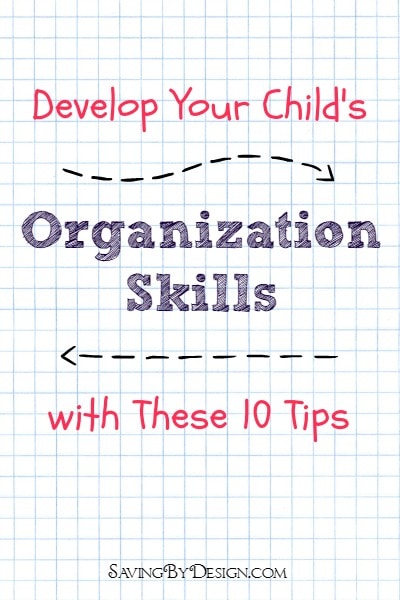
As we head into a new year, one of my big goals is to get my kids to help with organization. Lord knows there is plenty of clutter after many hours inside on a long, cold, winter day and it’s time to get them involved in helping to organize the chaos! I do give them credit, they do a pretty decent job in helping out when I ask them to. Even my 2-year-old is very enthusiastic when it comes time to put toys away or clean up the inevitable Cheerios on the floor. But, I know we can take it a lot further. Getting them to understand why it’s important to keep things organized, especially now that my son has entered the school years, will only help them become the responsible people I really want them to be. So let’s take some time to explore how to develop your child’s organization skills.
Right now in my home, with a 2-year-old and a 4-year-old, we really are all about getting to a point of understanding on why it helps the household when things are picked up, everything is in its place, and their toys and clothes are organized. How to start? With a few simple guidelines to get everyone on the same page, along with some time, patience, and perseverance, you’ll knock it out of the park!
1. Have a set time where everyone goes over what they have planned for the week. Since my kids are still a little young for this it may not be a priority for me right now, but with older kids, making sure they understand what the week holds will help to keep the family organized. Time management is an important part in keeping families organized, so if everyone is on the same page for the week’s goals and activities, organization will be a perfect by-product.
2. Color-code different things in the house to help your child understand where items will need to put away if they don’t read yet. Even if they do read it’s always quite helpful to make sure things go in the right place with color-coding. For example, in my home we have shelves that are home to different things that belong to each of the kids in our playroom. My son’s shelves have some washi tape that is one color, while my daughter’s shelves have a different color of washi tape attached to them. When we start putting away the toys for the day, it’s easy for them to figure out who’s items go where, because of the color-coding system. It works like a dream! Stuffed animals also go in bins, so any stuffed animal that is out, needs to get put in a bin in the playroom, as well. Making it easy and understandable for your kids will help them to organize their belongings when it’s time to clean up. Take a look at my 12 must-have organizing products that help me tame the clutter in my home 😉
3. Checklists are a great thing to make sure the kids understand the things they will be responsible for on a daily basis. For example, I have daily checklists for my son, ranging from brushing teeth, helping with the dishes after meals, putting his coat away when coming back inside, etc. It took a bit of time to get him accustomed to the routines that were established with these checklists, but now that he is, it makes life so much more organized. He knows what is expected of him and it helps him to prioritize what he is going to need to do. Routines are a great thing for children and with routines come organization. These are different than “chores” that he may do to help with special things around the house, because these checklist items are daily tasks that need to be accomplished no matter what. It’s been working great!
4. Categorize things so they know what goes where. I want to make sure the kids fully understand that “everything has a home” and if I make sure I have clear systems down to help them put things away, it helps them learn organizing. For example, my son is a Lego King! I have more Legos right now in my home than any 4-year-old could possibly need. My son collects them and simply can’t get enough! But let me tell you something that I’m sure all of you other parents with Lego loving kids already know. Those little blocks find there way into EVERYTHING in my house! So…what to do?!?! I have stacked bins that were a quick, easy, and cheap purchase from a local dollar store and they have been heaven sent! My son now knows that ALL Legos needs to go in these bins. We’ve even color-coded the bins to make sure that he can sort the Legos according to color and always know what his “inventory” is. Sorting and categorizing are important parts of learning the basics of organization, and unless he is in the middle of a big project that he is working on on his Lego table, all of the Lego parts are sorted and categorized in the stacked bins. Much easier!
5. Establish a routine in order to set expectations. If your kids are in school, this could be something like making sure it is a known fact that in your house, between the hours of 4pm and 5pm, they are to do their homework. No matter what. This allows them to become used to a routine and organize their day accordingly. If your kids aren’t in school, maybe establish some sort of a daily routine such as “reading hour”, like I do in my home. My kids are a little too young to sit still for an entire HOUR of reading, but they do know that at a certain time, everyday, Mommy or Daddy will read to them and it can be expected and consistent. When kids have a routine and know what will be coming, it helps to set clear expectations that they will have to follow and stick to. By doing this, they know there is organization set up in their day, along with having to adhere to the routines and expectations in your home.
6. Prepare for the next day. This a big one! Morning and evening routines are organized events in this home and thank goodness for that! My son is in school now, which means that being organized and set to leave the house at a specific time are more important than ever. I have my son pick out his school clothes for the next day and we always put them in the same place at night. This way, we aren’t hemming and hawing for 20 minutes the next morning trying to figure out what he’s going to wear. It’s already done. Lunches? They are packed the night before, as well. We make sure together that his backpack is ready and by the front door in the evening, as well, and our mornings go much more smoothly as a result. With being organized it helps to control the stress level in the mornings and also lessens the need for raised voices when nobody seems to be listening to Mommy in the morning!
7. Break large projects into more manageable tasks. This may be more appropriate for older children, specifically with helping them with school projects, but even with younger kids, things that may seem too complicated for them become much more manageable when it’s broken down. Help your school-aged children learn how to organize school projects by working with them on the best way to complete them. Breaking down a book report, for example, becomes much more manageable when you first help them pick out a book and then get the supplies they may need to complete the assignment, before they become to overwhelmed and don’t want to do it at all. It helps them learn organization and figure out what to prioritize over other items.
8. Make a plan in the day for “clean-up” time so they are aware what is going to happen and aren’t taken by surprise. Having a time every day when “clean-up” is going to be for both of my kids kids has really helped to eliminate the meltdowns and tantrums that used to happen. They know this time is coming every day and when it arrives, it’s time to organize their playroom, bedrooms, and anywhere else they may have been playing with their toys. It helps that they have each other to rely on and guide them, and it’s even kind of cute watching my 2-year-old trying to emulate my 4-year-old picking up her toys! For older kids, you may want to even consider giving them planner to keep their days flowing and organized with a plan.
9. Once a year, do a massive de-cluttering of the home and do a large donation to Goodwill. We just completed it for this past year and I had my son help go through his toys and determine things he no longer needed or wanted and worked together to organize bags that could leave the home. There are so many things that the kids no longer use, that either end up getting tossed somewhere when they are searching for what they really want or end up getting trampled on in the process. One way to keep things organized is to make sure this clutter is gone.
10. Set a strong example! How are your kids going to learn to be organized individuals if we don’t put some effort into doing it ourselves? Trust me…I know how hard that can be! But I do my best to make sure that they see me organizing different things throughout the day and that they are aware of what I’m doing. It helps them to see their Mommy trying to keep the house in order or making lists for the things I need to get at the store.
When the kiddos learn the basics of how organization works, it can help to promote competence, self-esteem, and give them a sense of accomplishment that will make them proud. As a parents, we need to be encouraging and helpful. I definitely want my little ones to learn new skills and form some independence (as much as we want to be the ones who do EVERYTHING for them!). Working with my kids now will help to encourage productivity when they grow older and really need these skills and habits. So, we’ll see how it goes! I’m excited to have a little help around the house and put these ideas into action. I know the things I have already tried with the kids has gone over pretty well and it’s very rewarding as a parent to know that you’re doing the best for your kids, and helping them learn the life skills we all want our kids to grow up with.
Have you done to develop your child’s organization skills? Comment below and share your secrets to success! 🙂






Leave a Reply